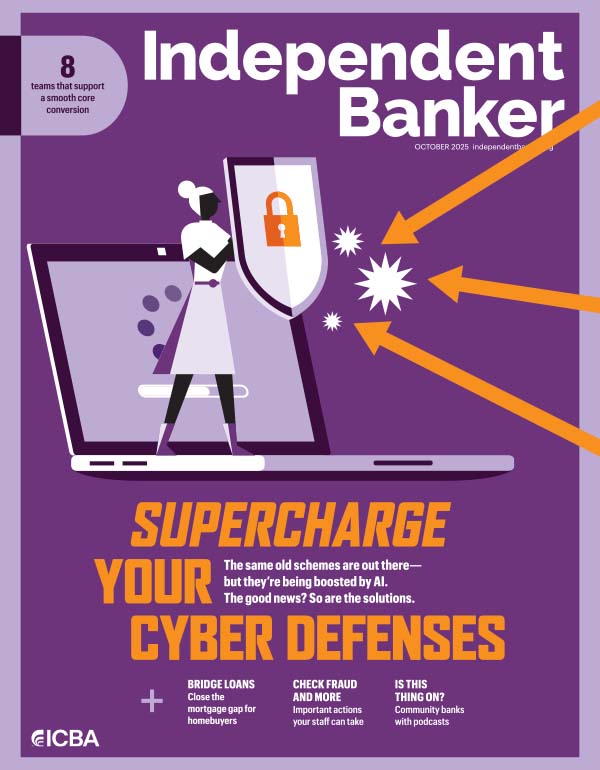When faced with staffing shortages, it’s not uncommon for community banks to turn to freelancers to fill in the gaps. This strategy offers a few potential benefits when compared with hiring full-time employees (FTEs).
Sandy Moll founded Advanced Business Solutions in 2008 with the goal of helping community banks meet staffing challenges.
“Using freelancers and independent contractors wasn’t as common back then as it is today,” she says. “It can be a great solution to dealing with staffing shortages in the right circumstances, but it has to be done right.”
Defining a freelancer
A freelancer is an individual who completes work on a project or contract basis, instead of as an FTE. Freelancers are usually paid on an hourly or project basis and don’t receive benefits from the employer, such as health insurance or retirement plan contributions. Sometimes, freelancers are referred to as 1099 employees, because they receive a 1099 tax form reporting their freelance income, instead of a W-2 tax form like FTEs receive.
One thing to note: Employers don’t withhold income taxes from freelancers’ pay. Instead, these independent workers are responsible for paying their own income taxes, including Social Security and Medicare taxes.
Community banks can hire freelancers to perform a wide range of different functions. Some of the most common include copywriting and editing; social media management; website and graphic design; marketing and media relations; IT and cloud computing; software engineering; and data processing.

“Full-time staff members at many community banks wear lots of different hats,” says Rob Birgfeld, ICBA executive vice president and chief marketing officer. “Bringing in freelancers can be a good solution when the bank needs more help than all-hands-on-deck can provide.”
When hiring freelancers makes sense
Contract workers are especially useful for short-term projects or during periods when there’s more work than full-time staff can handle. “Banks don’t have to spend the time and money required to hire FTEs when the individuals might not be needed permanently,” says Birgfeld. “Also, by bringing in freelancers, banks may benefit from deeper expertise in a particular area and the perspective of someone from outside the bank.”

Michael Berman, founder and CEO of Ncontracts, which provides risk and compliance management software for community banks, concurs. “By hiring freelancers, you don’t have to make a long-term commitment when you only have a short-term need,” he says.
Moll says that freelancers provide a ready resource pool you can easily tap into when faced with temporary staff shortages, such as an employee’s vacation or maternity or sick leave. “Also, freelancers can serve as a stopgap while you search for a full‑time employee,” she says. “Filling open positions can take a long time, so freelancers give you more time to make sure you make the right hire.”
There’s even potential for contract‑to-hire positions, where freelancers can eventually become FTEs. Hiring them first as freelancers gives community banks an opportunity to “try it before you buy it,” says Moll. “It helps reduce the hiring risk because you can find out if the person is a good fit for the job before making a full‑time hiring commitment.”
Complying with regulatory guidance
Berman notes that freelancers are considered vendors for the purposes of the Interagency Guidance on Third-Party Relationships: Risk Management. “This means freelancers are subject to all the risk management practices for stages in the life cycle of third-party relationships,” he says. These practices include planning, due diligence and third-party selection, contract negotiation, ongoing monitoring and termination.
Community banks need controls in place for hiring freelancers, even if they use a staffing agency.
“You can’t outsource this responsibility,” says Berman. “For example, be sure to verify and document that you have performed background checks on freelancers, since this is a regulatory requirement. From a regulatory standpoint, if it’s not documented, it hasn’t been done.”
Complying with third-party risk management practices is especially important when working with IT personnel who handle sensitive customer data. “If you share customer data with an IT freelancer, you’re responsible for making sure the data is secure,” says Berman. “So, you have to ensure they have data protection protocols in place. This is sometimes overlooked by community banks, which can be an expensive mistake.”
Best practices for hiring freelancers
Big Stat
72.1M
The number of freelancers in the U.S. as of 2023
Source: MBO Partners
Moll says that building a network of freelancers “is simple, but it’s not easy. It requires a lot of time and planning to get it right,” she says. “So, community banks have to decide if they want to do this themselves or work with a staffing agency.”
It’s a good idea to prepare a list of potential freelancers you might need ahead of time, so you’re ready when the need arises. “Talk to other bankers about how they have sourced freelancers, so you don’t have to start from scratch,” says Berman.
ICBA’s Community hub is a great resource for finding freelancers, says Birgfeld. “A real value-add of association membership is the online peer network, where community bankers can connect with one another on staffing solutions and other topics. Also, search online platforms and job boards like LinkedIn, Fiverr and UpWork, where you can search for freelancers by different verticals like creative, IT or marketing automation.”
You should treat the freelancer vetting process just like you would when hiring an FTE. “Perform background checks, check references and ask to see samples of work candidates have performed that demonstrate their capabilities,” says Moll. “For example, if a freelancer is going to do loan review, you could send credit files for candidates to review so you can test their knowledge.”
Birgfeld says it’s critical to set clear expectations up front with freelancers about your expectations for deliverables. “This includes the scope of work and project deadlines,” he says. Prepare a statement of work that includes these and other project details such as the pay rate and pay schedule, where the work will take place, whose equipment will be used and who owns the finished work product. Also consider having freelancers sign a non‑disclosure agreement.
Look for the right cultural fit
Moll believes that cultural fit can be just as important for freelancers as it is for FTEs. “It’s easy to just look at a resume and cover letter and see if a freelancer has the right skill set for a job,” she says. “But if the candidate isn’t a good cultural fit with your organization, this could cause problems. Hiring freelancers who don’t fit the culture is one of the biggest mistakes I’ve seen banks make.”
Establishing a secure freelancer network comes down to having a plan. “Lots of things can go wrong if you don’t,” says Berman. “Think through all the details, including compliance with the interagency guidance, and devise a plan for success.”
Freelancer or FTE?
When hiring freelancers, it’s critical to make sure that you have indeed hired a freelancer and not a full‑time employee. The distinction is important for determining whether you must withhold a portion of the worker’s wages to pay income, Social Security, Medicare and unemployment taxes.
Making the wrong worker classification can be costly. If the IRS determines that you have misclassified an employee as a freelancer or independent contractor, you could be liable for paying the worker’s employment back taxes, along with tax penalties.
The IRS considers three main aspects of the employer–worker relationship when making the employee–freelancer determination:
Behavioral: What level of control does the company have over the jobs performed by workers and how they do their jobs?
Financial: What level of control does the company have over business aspects of the job, such as how workers are paid, whether expenses are reimbursed and who provides tools needed to perform the job?
Type of relationship: Is the nature of the employer–worker relationship ongoing or temporary? Also, are there written contracts, and does the business provide the worker with benefits such as health insurance and paid vacation?
The IRS encourages businesses to view the entire employer–worker relationship when making the determination and to keep thorough documentation of all relevant factors.






